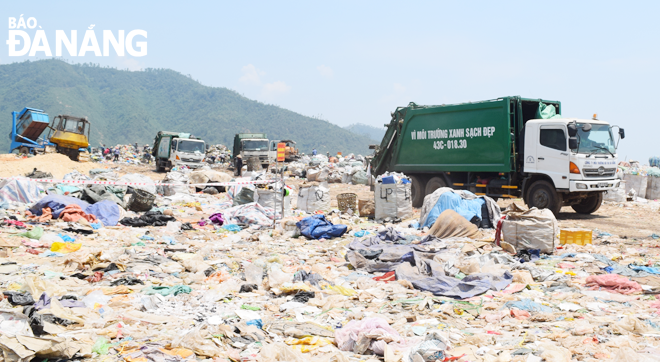Da Nang seeks ways to reduce plastic waste for environmental protection
Domestic and international scientific research organisations and experts have calculated the initial data related to the annual emission of plastic waste in Da Nang to make a basis for implementing appropriate solutions to the deeply concerning pollution in the coming time.
 |
| Currently, 85% of the total city-wide generated plastic waste volume is sent to the Khanh Son landfill. Photo: HOANG HIEP |
Every year, 80,000 tonnes of plastic waste are generated
In recent years, the concept of ‘white pollution’ is no longer strange. ‘White pollution’ refers to solid waste which comes from the usage of various types of plastic products. Most plastic bags, which are a major source of pollution in the country, serve for around 10 minutes, but take up to a millennium to degrade.
According to statistical results, plastic bags are the main finished products, identified as the direct cause of plastic waste pollution, adversely effecting the natural environment.
According to Dr. Pham Ngoc Bao from the Institute for Global Environmental Strategies (IGES), through the results of component analysis and advanced modeling, it has been calculated that nylon bags account for 48.4% of the total plastic waste components discharged into the environment, whilst plastic film with 18%, plastic spoons, cups and straws 7.6%, plastic foam 4%, and plastic beverage bottles 7.8%.
Dr. Pham Phu Song Toan a lecturer from the Environmental Technology at the University of Technical Education said that, each year, Da Nang see an average of 80,000 tonnes of waste be discharged into the environment, equivalent to the daily discharge of 0.19kg by an individual.
Currently, 85% of the total city-wide generated plastic waste volume is sent to the Khanh Son landfill, of which only 6.2% is sorted for recycling, whilst 8% is classified as uncontrolled plastic waste, potentially causing damage to the environment and ecosystem.
It is estimated that, every year, up to 5,692 tonnes of plastic waste, equivalent to 7.2% of the total city-wide generated plastic waste volume, end up on land or in drains and trenches, thus easily leading to sewer blockages.
Therefore, if no sanitation solutions taken, such a large amount of plastic waste will decompose into countless microplastics of many types, and inevitably polluting the surrounding environment.
Many anti-white pollution models needed
In his perspectives, Dr. Pham Phu Song Toan recommended: “Pollution caused by plastic bags is a worrying situation in Da Nang. It is high time for the city, in a prompt fashion, to take effective measures in a bid to handle plastic bag products for ‘white pollutio’ reduction.
Focus should be placed on reducing indiscriminate littering and illegal dumping, in parallel with increasing plastic recycling, improving integrated solid waste management and promoting 3R activities (Reduce, Recycle, Reuse), and also especially, promoting the participation of the private and public sectors in pollution mitigation drives.
It is a need to raise public awareness of the harmful impacts of plastic waste on the environment, encouraging them to consume biodegradable products, and promote the classification of trash right at families into 3 types - organic, inorganic, and recycled.
According to the municipal Women's Union, over the past times, all of its chapters have encouraged their member women to use shopping baskets instead of single-use plastic bags, and promote banana leaf packaging.
Vegetables are simply wrapped in a banana leaf and secured using a flexible piece of bamboo. Banana leaves are a great alternative to plastic as the leaf is large, thick and supple enough to be folded.
Deputy Director of Environmental Protection Sub-Division under the Department of Natural Resources and the Environment Nguyen Thi Kim Ha informed that, at present, her agency and other relevant agencies are implementing projects in cooperation with many international organisations and NGOs at home and abroad to mobilize resources, grasp experience and master techniques to strengthen solid and plastic waste management, and the classification of domestic solid waste at the source.
With the great support and active companionship of organisations such as United Nations Development Organisation (UNDP), International Union for Conservation of Nature (IUCN), U.S Agency for International Development (USAID), Centre for Supporting Green Development (GreenHub), Center for Environment and Community Research (CECR) and Yokohama city in Japan, Da Hang will effectively implement many projects on at-source solid waste sorting and combat the use of plastic waste, thus contributing to solving ‘white pollution’ issue of deep concern.
Reporting by HOANG HIEP – Translating by A.T